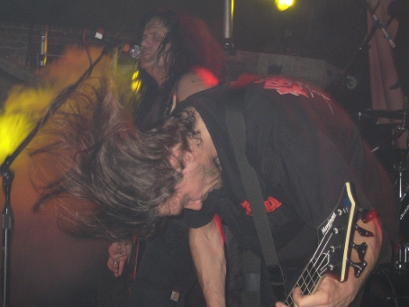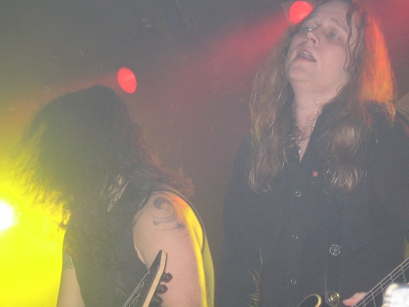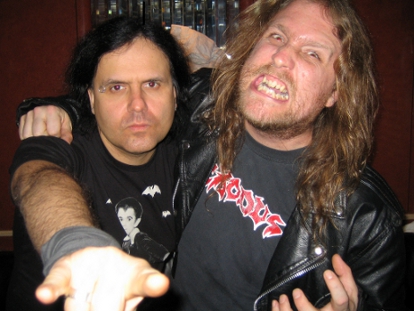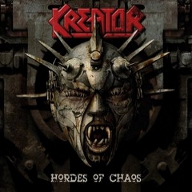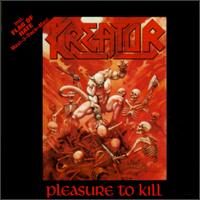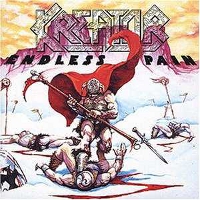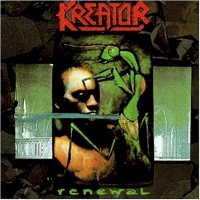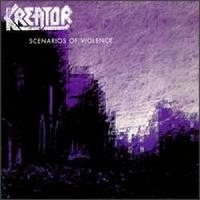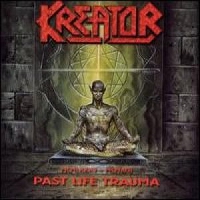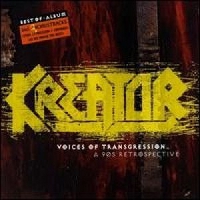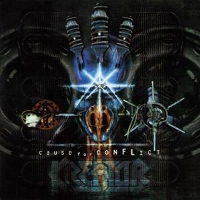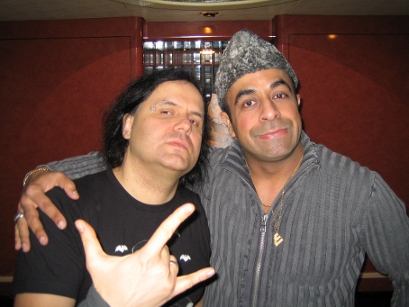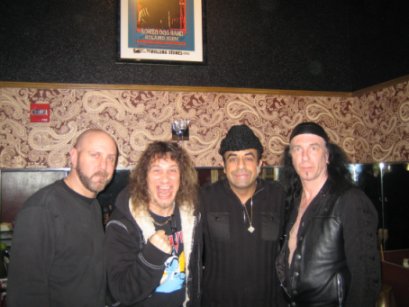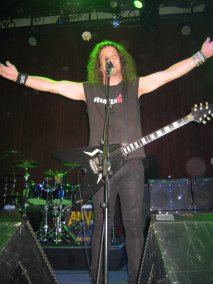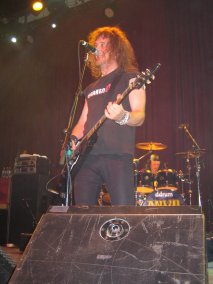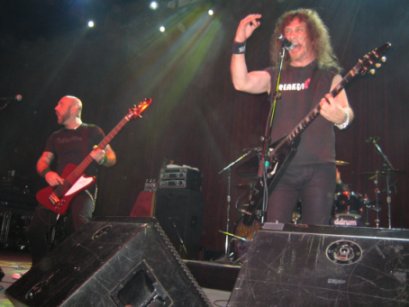Concert Review: Exodus
(San Francisco, CA, Slim’s, 12-06-10)
On Sunday, June 12, 2010 Exodus played a record release show at Slim’s nightclub. Exodus played a 16 song, 110 minute set from 10:51 to 12:41.
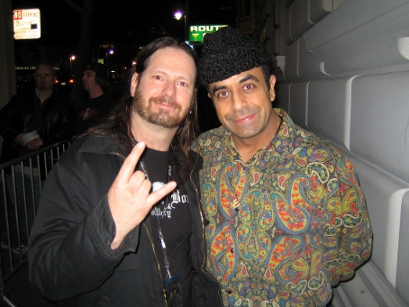
1. Ballad of Leonard and Charles (Exhibit B: The Human Condition record, 2010) began with a tape track for the 60 second introduction. Approximately the first 30 seconds of the introduction (approximations presumed throughout) solely featured an acoustic guitar while the second half was augmented by keyboards. The band walked on stage and Gary Holt (“GH,” guitarist) and Lee Altus (“LA,” guitarist) played pummeling mid tempo guitar riffs also featured during the last 50 seconds of Bedlam 123 off The Atrocity Exhibition … Exhibit A record (2007). GH played a smoldering series of short, high guitar notes during the second half of the riff rampage. The band stopped playing for one second followed by GH and LA’s chugging high tempo guitar riffs augmented by Tom Hunting’s (“TH’s,” drummer) thundering drumming and Jack Gibson’s (“JG’s,” bassist) solid driving bass lines. Rob Dukes (“RD,” vocalist) screamed the first verse and chorus with ferocity. During the first chorus TH smashed his Paiste cymbals, and RD screamed the final word, “Violeeeeeeeence.”
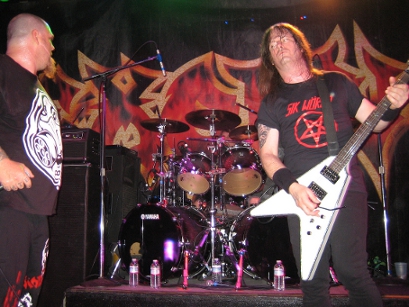
The second verse was preceded by a seven second interlude that featured GH and LA’s chugging riffs. After the second chorus the band engaged in a 30 second jam session that highlighted TH’s drumming with prominent use of his cymbals. TH wore knee length, camouflage grey, cotton shorts, black Sik World (merchandising brand) muscle shirt with the “Sik World” logo in red letters on his chest. TH played a grey to black fade Yamaha drum kit featuring silver speckles and double bass drums. The third verse contained a vocal exchange between GH and RD. GH sang the introductory word of the odd numbered verse lines (e.g., “Fear – A macabre madness. Fiendish carnage with rabid butchery.”), whereby he chanted the following words throughout the third verse, “Fear, pain, rape, slave, sado, sick, lie, kill, death.” [Apropos words to comprise a Hallmark greeting card.] LA and GH then traded guitar solos for 60 seconds followed by RD singing the third verse and chorus. The song concluded with feedback from GH and LA’s guitars that led straight into Beyond the Pale.
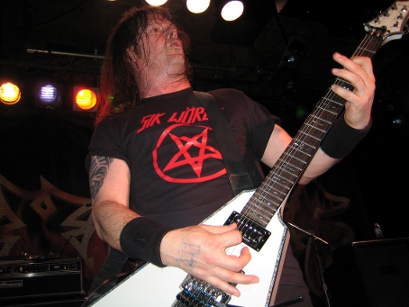
2. Beyond the Pale (Exhibit B: The Human Condition, 2010) is an up tempo thrasher that began with TH’s thundering drumming and GH and LA’s chugging guitar riffs during which GH briefly played lingering guitar notes for a few seconds before resuming riffing. RD sang the first verse and pre chorus. Between the first pre chorus and second verse GH and LA played chugging guitar riffs for 20 seconds that ended with a series of complicated TH drum fills. The second verse contained poignant lyrics, “Take the gun. Take the knife. Take the pain. Then take the life. My taste for homicide … is rising up and amplified. Bloody deeds, my only friend … with me ‘til the bitter end. Together we are one. And our work has just begun.” RD then sang the second pre chorus and first chorus. The band jammed for 35 seconds followed by GH’s 40 second guitar solo. GH wore black combat boots, black jean pants, black Sik World t-shirt with “Sik World” and a pentagram in red letters on his chest, and black sweatbands on his forearms. GH played a white B.C. Rich flying V guitar with pearl trim. The band jammed for 70 seconds after which RD sang the third verse, third pre chorus, and second chorus. The song came to a raucous conclusion with LA’s 50 second guitar solo.
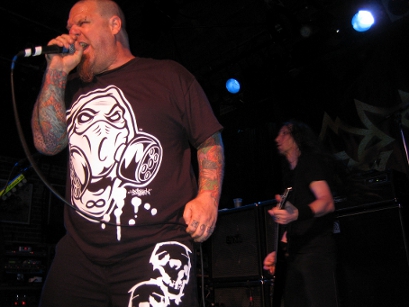
3. Iconoclasm (The Atrocity Exhibition … Exhibit A, 2007). Before Iconoclasm RD commented on how some of the audience members in the mosh pit were engaging in “old school moshing,” including “one dude who was stepping on people’s heads.” RD wore black Vans high top shoes with white trim, knee length, black, cotton shorts with a red “Exodus” logo printed on the left leg, and black t shirt bearing a large caricature of the head of a figure wearing a gas mask on the back of which read in white letters, “The truth can be oppressed for only so long.” [RD bears a slight resemblance to George “Spanky” McFarland, American child actor in “The Little Rascals (a.k.a. “Our Gang”) American comedy short films (1922-1944). I am sure RD will “spank” my butt for calling him “Spanky.”] Iconoclasm began amidst GH and LA’s thrash infused guitar riffs and TH’s double bass drums. After a 60 second introduction RD sang the first verse at a mid tempo pace and slightly lower than usual octave. RD then sang the second verse, which was preceded by a 15 second display of frenetic riffing by GH and LA and tom tom pummeling by TH. RD then sang the second chorus with the tempo slowing down to a mid tempo pace when he sang the final word (i.e., “free”). GH and LA played heavy guitar riffs for 40 seconds after which RD sang the third verse and GH played a 35 second guitar solo. The tempo then resumed an up tempo pace and the band engaged in a two minute jam session during which LA played a 30 second guitar solo. RD then sang the third verse and chorus.
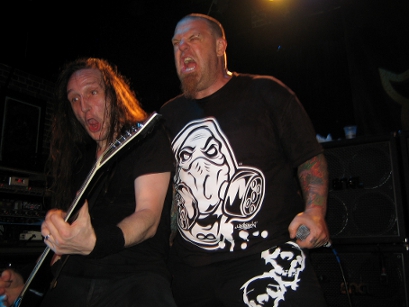
4. Metal Command (Bonded by Blood, 1985) began with LA’s palm muted guitar riffs and TH’s drumming above which GH laid the song’s signature guitar chord progression. RD sang the first verse and chorus. The second verse was preceded by a 10 second interlude during which GH and LA played guitar chord progressions. RD then sang the second verse and chorus followed by a 45 second GH guitar solo and a 25 second jam session. RD then sang the third verse and chorus with the former containing particularly memorable lyrics, “Our legions show no mercy. The final hour nears. Sonic blast deafening. It’s ripping through your ears. There is no retribution … for those who do not dare. There’s only execution. You’re dead without a prayer.”
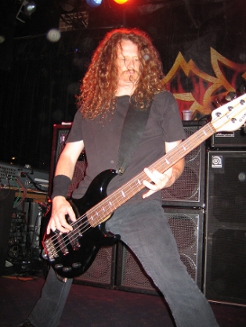 5. Downfall (Exhibit B: The Human Condition, 2010). Before Downfall RD said, “How many metalheads do we have here tonight? How many of you watch that show Metalocalypse [animated television series about a death metal band called Dethklok]? Well the director of that show [Jon Schnepp] shot our latest video. It is coming out in a week or some sh*t like that. It’s called Downfall.” [Note to self: buy a Little Rascals calendar as RD’s practical Christmas gift.] The first 45 seconds of the song featured GH playing harmonic guitar notes atop LA and JG’s solid rhythm chords. JG wore black combat boots, black jean pants, plain black t-shirt, and black sweatband on his right forearm. JG played a black Yamaha five string bass and used Ampeg amplifiers (“amps”). [JG is the metal equivalent of Johnny Cash (American country singer, guitarist dubbed “The Man in Black”). Also, JG’s mustache and beard remind me Porthos, the fictional character in Alexandre Dumas, père’s novel, The Three Musketeers (1844).
5. Downfall (Exhibit B: The Human Condition, 2010). Before Downfall RD said, “How many metalheads do we have here tonight? How many of you watch that show Metalocalypse [animated television series about a death metal band called Dethklok]? Well the director of that show [Jon Schnepp] shot our latest video. It is coming out in a week or some sh*t like that. It’s called Downfall.” [Note to self: buy a Little Rascals calendar as RD’s practical Christmas gift.] The first 45 seconds of the song featured GH playing harmonic guitar notes atop LA and JG’s solid rhythm chords. JG wore black combat boots, black jean pants, plain black t-shirt, and black sweatband on his right forearm. JG played a black Yamaha five string bass and used Ampeg amplifiers (“amps”). [JG is the metal equivalent of Johnny Cash (American country singer, guitarist dubbed “The Man in Black”). Also, JG’s mustache and beard remind me Porthos, the fictional character in Alexandre Dumas, père’s novel, The Three Musketeers (1844). 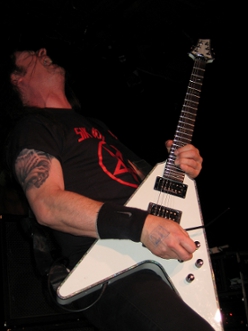 I would not be surprised if JG came on stage wielding a sword in lieu of a bass and chanted, “All for one, one for all.”] GH and LA then played churning mid tempo guitar riffs that continued into the first verse followed by the first chorus with a slightly escalated tempo. The first chorus fluidly transitioned into the second verse during which the tempo momentarily slowed down only to return to the higher tempo during the second chorus.
I would not be surprised if JG came on stage wielding a sword in lieu of a bass and chanted, “All for one, one for all.”] GH and LA then played churning mid tempo guitar riffs that continued into the first verse followed by the first chorus with a slightly escalated tempo. The first chorus fluidly transitioned into the second verse during which the tempo momentarily slowed down only to return to the higher tempo during the second chorus.
The song’s highlight came after the second chorus when the tempo slightly slowed down, JG and TH delivered a heavy series of bass lines and drum beats, and GH and LA played ominous guitar riffs. [The suspenseful eerie mood the band created was equivalent to the laboratory scene in James Whale’s classic horror film, “Frankenstein” (1931) when the mad scientist successfully brought his wretched creation to life.] The audience thrice chanted, “Fall” and RD screamed, “Downfall!” [My downfall came during the first three songs when various crowd surfing limbs toppled on me like rainfall in the two feet wide photo pit.] GH then played a 35 second guitar solo followed by the third verse and chorus. During the third chorus the audience repeatedly chanted, “Hay” and pumped their fists in the air. The song ended with a 50 second cascade of GH and LA guitar riffs. Downfall, along with another song to be performed, received the strongest audience reaction of the five new songs the band performed.
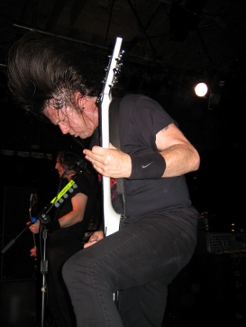 6. A Lesson in Violence (Bonded by Blood, 1985). Before A Lesson in Violence RD said, “You are always so awesome. This band has been tearing it up since 1982. Our new record still shows we thrash the right way. We do it just the right way, fast and heavy.” A Lesson in Violence is an up tempo thrasher that began with GH and LA’s chainsaw like guitar riffs followed by RD singing the first verse, “If you got something to say then come my way. I’m guarded by Satan I’m riding on Baphomet. I’ll teach you a lesson in violence you won’t soon forget. The pleasure of watching you die is what I will get.” RD then sang the first chorus followed by a 15 second interlude that featured a battery of GH and LA guitar riffs atop TH’s thundering drums. Robb Flynn (Machine Head’s vocalist, rhythm guitarist) came on stage and sang the second chorus. GH and LA then played guitar solos for 60 seconds after which they locked into tight riffing. The mosh pit during A Lesson in Violence, along with two more songs to be performed, was particularly violent, hence the song title.
6. A Lesson in Violence (Bonded by Blood, 1985). Before A Lesson in Violence RD said, “You are always so awesome. This band has been tearing it up since 1982. Our new record still shows we thrash the right way. We do it just the right way, fast and heavy.” A Lesson in Violence is an up tempo thrasher that began with GH and LA’s chainsaw like guitar riffs followed by RD singing the first verse, “If you got something to say then come my way. I’m guarded by Satan I’m riding on Baphomet. I’ll teach you a lesson in violence you won’t soon forget. The pleasure of watching you die is what I will get.” RD then sang the first chorus followed by a 15 second interlude that featured a battery of GH and LA guitar riffs atop TH’s thundering drums. Robb Flynn (Machine Head’s vocalist, rhythm guitarist) came on stage and sang the second chorus. GH and LA then played guitar solos for 60 seconds after which they locked into tight riffing. The mosh pit during A Lesson in Violence, along with two more songs to be performed, was particularly violent, hence the song title.
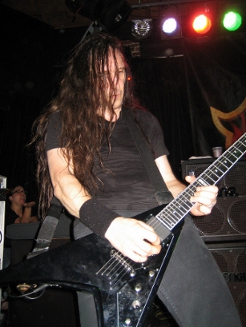 7. Fabulous Disaster (Fabulous Disaster, 1989). Before Fabulous Disaster RD said, “Are you guys tired? You want us to slow it down? You want some slow sh*t? How about something from 1989? Fabulous Disaster!” The song’s introduction featured LA playing a mid tempo guitar chord progression amidst red and blue stage lights while standing on TH’s 18 inch high, black colored wooden drum riser. GH played a series of frenetic guitar riffs atop LA’s guitar chord progression. At the 0:45 mark LA joined GH in frenetic riffing that continued into the first verse. LA wore black sneakers, black jean pants, plain black t shirt, and black sweatbands on his forearms. LA played a black ESP flying V guitar. [LA has so much lengthy hair he reminds me of a troll doll (toy doll fad created by Danish fisherman, woodcutter Thomas Dam (1959)), albeit more tamed and not as “poofy.”] Fabulous Disaster contained a particularly catchy chorus. The tempo momentarily slowed down before RD sang the final two lines of the first chorus but resumed an up tempo pace in time for GH’s 40 second guitar solo. After GH’s guitar solo LA once again played a mid tempo guitar chord progression atop which GH played frenetic guitar riffs. LA eventually joined GH in frenetic riffing that continued into the second verse followed by the second chorus that ended when RD screamed, “Fabulous disaster!”
7. Fabulous Disaster (Fabulous Disaster, 1989). Before Fabulous Disaster RD said, “Are you guys tired? You want us to slow it down? You want some slow sh*t? How about something from 1989? Fabulous Disaster!” The song’s introduction featured LA playing a mid tempo guitar chord progression amidst red and blue stage lights while standing on TH’s 18 inch high, black colored wooden drum riser. GH played a series of frenetic guitar riffs atop LA’s guitar chord progression. At the 0:45 mark LA joined GH in frenetic riffing that continued into the first verse. LA wore black sneakers, black jean pants, plain black t shirt, and black sweatbands on his forearms. LA played a black ESP flying V guitar. [LA has so much lengthy hair he reminds me of a troll doll (toy doll fad created by Danish fisherman, woodcutter Thomas Dam (1959)), albeit more tamed and not as “poofy.”] Fabulous Disaster contained a particularly catchy chorus. The tempo momentarily slowed down before RD sang the final two lines of the first chorus but resumed an up tempo pace in time for GH’s 40 second guitar solo. After GH’s guitar solo LA once again played a mid tempo guitar chord progression atop which GH played frenetic guitar riffs. LA eventually joined GH in frenetic riffing that continued into the second verse followed by the second chorus that ended when RD screamed, “Fabulous disaster!”
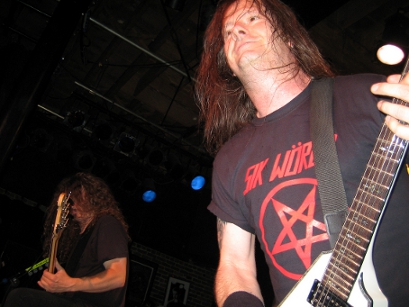
8. Blacklist (Tempo of the Damned, 2004). Before Blacklist RD said, “Is everybody drinking and getting stoned or what?! [For a nanosecond my cross-wired brain misinterpreted RB with a literal interpretation of “getting stoned,” the capital punishment whereby an organized group throws stones at an individual until death. This punishment seems a bit drastic for drinking but then again fundamentalist countries condone stoning. All it would take to crack my puny skull is a pebble.] We forgot our weed but we are home now. When we say we need weed people just throw it on stage. How cool is that?! This one is called Blacklist.” Blacklist is a catchy mid tempo rocker that began with GH and LA’s basic, chugging guitar riffs and TH’s solid tom tom drums. The audience repeatedly chanted, “Hay” while RD screamed, “Bang your fu**in’ heads!” RD sang the first two verses and choruses in standard verse chorus pattern. The band then jammed for 30 seconds followed by GH and LA guitar solos for 50 seconds. The song concluded with RD singing the third verse and chorus.
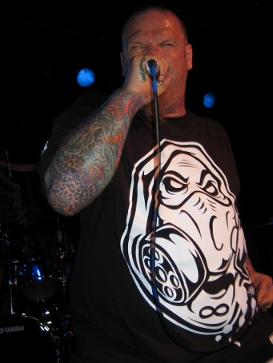 9. The Sun is My Destroyer (Exhibit B: The Human Condition, 2010). Before The Sun is My Destroyer RD said, “I heard some guy up front yell, ‘Play some new sh*t.’ This one is called, The Sun is My Destroyer.” The Sun is My Destroyer is an epic song nearly 10 minutes in length. [It was long enough for me to read Leo Tolstoy’s 1225 page novel, “War and Peace” (1869) followed by a facial.] During the first 45 seconds GH and LA played recurring guitar riffs and TH a mid tempo, heavy tom tom beat. TH then kicked the song into overdrive with insanely fast drumming on par with Dave Lombardo (Slayer drummer). RD sang the first verse and chorus with a death metal vocal style. The first verse’s lyrics fit the death metal theme, “Immortal subjugator, usurper, dominator. Blood ruler of the dark. Lord of the shadow world, flag of black unfurled. Foul, unholy patriarch. Enslaver of mankind, king of all unkind. Light ender in black domain. I fear only the dawn, at war with the rising sun. Eternal dusk ordained.”
9. The Sun is My Destroyer (Exhibit B: The Human Condition, 2010). Before The Sun is My Destroyer RD said, “I heard some guy up front yell, ‘Play some new sh*t.’ This one is called, The Sun is My Destroyer.” The Sun is My Destroyer is an epic song nearly 10 minutes in length. [It was long enough for me to read Leo Tolstoy’s 1225 page novel, “War and Peace” (1869) followed by a facial.] During the first 45 seconds GH and LA played recurring guitar riffs and TH a mid tempo, heavy tom tom beat. TH then kicked the song into overdrive with insanely fast drumming on par with Dave Lombardo (Slayer drummer). RD sang the first verse and chorus with a death metal vocal style. The first verse’s lyrics fit the death metal theme, “Immortal subjugator, usurper, dominator. Blood ruler of the dark. Lord of the shadow world, flag of black unfurled. Foul, unholy patriarch. Enslaver of mankind, king of all unkind. Light ender in black domain. I fear only the dawn, at war with the rising sun. Eternal dusk ordained.”
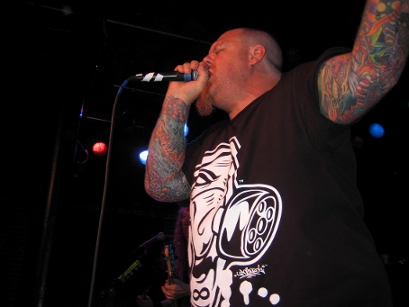
After a 20 second interlude featuring GH, LA, and JG’s frenetic riffing RD sang the second verse and chorus. Before the third verse the tempo significantly slowed down, and RD sang with less growl and more emotion. The slow tempo continued during GH and LA’s guitar solos that lasted 60 seconds. Before RD sang the fourth verse and final chorus the song resumed a frenetic pace replete with TH’s rollicking, thunderous drumming. During the final chorus white lights positioned on the stage floor stage left and right shined on the band as RD sang, “The sun is my destroyer.” [The light was bright enough for RD to have taken off his shirt, gotten basted with sun tan lotion, and bronzed. I would have loaned RD the cucumber slices from my facial to protect the delicate skin around his eyes.] During the last 1:40 seconds of the song the band showed its musical prowess by jamming at an insanely high tempo. After the song concluded RD said, “That is the first time we played that. We played it just for you. Next time we play that I want you all to sing along.” The Sun is My Destroyer, along with Downfall, received the strongest audience reaction of the five new songs the band performed.
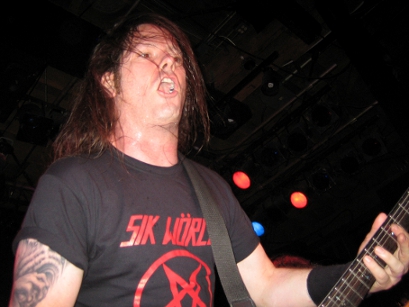
10. War is My Shepherd (Tempo of the Damned, 2004). Before War is My Shepherd RD said, “I want a big pit for this song. This one is called War is My Shepherd.” During the introduction to this up tempo thrasher GH played sinister guitar riffs and TH bashed his tom tom drums. The pace and first verse’s lyrics set the tone for intense moshing, “You put your faith in Christianity. I put mine in artillery. My M 16 my lord and savior. Christ never done me a motherf**king favor.” [GH may not place high priority on grammar, but his prolific memorable songwriting skills are among the best in the metal genre.] RD sang the first two verses and choruses in standard verse chorus pattern. During the choruses the audience sang along with vigor. After the second chorus GH played a 20 second guitar solo.
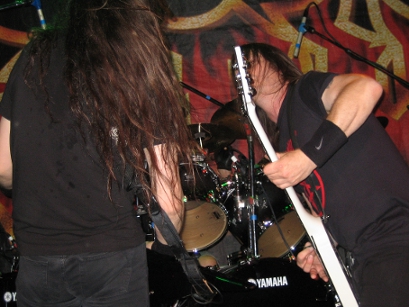
The aural attack did not let up as the band then engaged in a 45 second jam session during which GH and LA stood center stage facing each other. RD then sang the third verse, “Farwell, Graham and Farrakhan. They need god, I need napalm. Praise the lord and pass the ammunition. My sermon is my demolition.” [These lyrics evidence GH’s noteworthy ability to write simple yet poignant lyrics. GH is a guru at using few words to effectively convey his views and make listeners ponder. GH would have a lucrative career as a Satanic monk, if such a job title existed, preaching the virtues of the dark overlord.] The third chorus was followed by a 20 second LA guitar solo. The mosh pit during War is My Shepherd, A Lesson in Violence, along with one more song to be performed, was particularly ravenous.
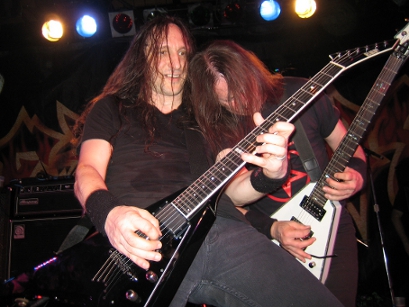
11. Impaler (Tempo of the Damned, 2004). Before Impaler RD said, “Now I am seeing old school mother fu**in’ moshing here tonight. This one goes out to (Paul) Baloff [late, original Exodus vocalist]. It is called the Impaler.” Impaler is a solid rocker that began with JG and TH’s heavy, mid tempo bass lines and drum beats, as well as GH and LA’s palm muted guitar riffs. A 15 second interlude that featured GH and LA’s guitar riffs separated the first two verses. After the second verse RD screamed, “Everyone go insane!” RD’s command served as the battle cry for the tempo to significantly increase as he sang the first chorus.” LA then played a three second guitar run followed by the second chorus during which white stage lights were syncopated with TH’s pulsating drum beats. LA then played a brief guitar solo followed by the third and final chorus. During the last two minutes of the song the tempo slowed to a mid tempo pace and the band engaged in a jam session. Impaler was the second consecutive song the band played off Tempo of the Damned (2004), but it was written by TH, GH, and Kirk Hammett (former Exodus and current Metallica guitarist) in 1982.
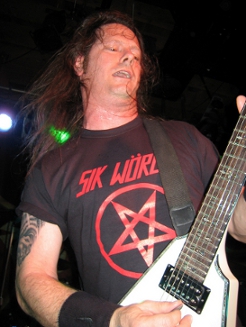 12. Strike of the Beast (Bonded by Blood, 1985) is an all out thrasher that featured GH and LA’s fluttering guitar riffs and TH’s monstrous double bass drums. RD sang the first verse and chorus as if spitting poison out of his mouth. After a 10 second interlude that highlighted GH and LA’s tight riffing RD sang the second verse and chorus. One of the two song highlights took place after the second chorus when the tempo momentarily slowed down and RD said, “I want to thank all you guys for coming out tonight. I want you to pick a side. (the pit audience separated into two clusters) I want everyone over here [stage left] to kill everyone over there [stage right], and I want you [stage right] to kill everyone over there [stage left]. C’mon spread it out more! No one goes ‘til I say … hold … hold … hayyyyyyyy!” The fans in the two pit clusters rushed toward each other and violently collided. [The fury with which the two warring factions collided was like a battle scene from Peter Jackson fantasy adventure film trilogy, “The Lord of the Rings” (2001-2003).]
12. Strike of the Beast (Bonded by Blood, 1985) is an all out thrasher that featured GH and LA’s fluttering guitar riffs and TH’s monstrous double bass drums. RD sang the first verse and chorus as if spitting poison out of his mouth. After a 10 second interlude that highlighted GH and LA’s tight riffing RD sang the second verse and chorus. One of the two song highlights took place after the second chorus when the tempo momentarily slowed down and RD said, “I want to thank all you guys for coming out tonight. I want you to pick a side. (the pit audience separated into two clusters) I want everyone over here [stage left] to kill everyone over there [stage right], and I want you [stage right] to kill everyone over there [stage left]. C’mon spread it out more! No one goes ‘til I say … hold … hold … hayyyyyyyy!” The fans in the two pit clusters rushed toward each other and violently collided. [The fury with which the two warring factions collided was like a battle scene from Peter Jackson fantasy adventure film trilogy, “The Lord of the Rings” (2001-2003).]
GH, LA, JG, and TH then engaged in the song’s second highlight, a 20 second jam session that was testament to the band’s undeniable music prowess and that fluidly led into the third verse after which LA and GH played guitar solos for 40 seconds. RD then sang the fourth and final verse. During the final 15 seconds of the song LA pulled a pre teen boy from front row, strapped his guitar on the bewildered boy, and encouraged him to strum the guitar. The boy enjoyed strumming LA’s guitar so much that GH and LA’s guitar technician eventually came over and gently removed the guitar. The mosh pit during Strike of the Beast, along with War is My Shepherd and A Lesson in Violence, was particularly tumultuous with Strike of the Beast reigning as the song that unleashed the greatest fury. The band left the stage at 12:17 and returned in one minute to play four additional songs.
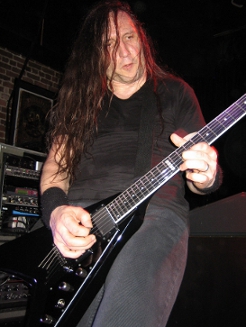 13. Bonded by Blood (Bonded by Blood, 1985). Before Bonded by Blood TH came center stage and said, “Shh. I want to dedicate this show to Debbie Abono [late Bay Area manager of numerous thrash and death metal bands during the 1980’s and 1990’s who succumbed to cancer on May 16, 2010]. She was like a mother to a lot of us. But you know what? She went out the same day as Ronnie James Dio [late Black Sabbath, Dio, Rainbow singer who also succumbed to cancer on May 16, 2010] so she is in a good place.” As a tribute to Ronnie James Dio, GH played a part of the melody of Holy Diver from Dio’s Holy Diver record (1983) and Gates of Babylon from Rainbow’s Long Live Rock ‘n’ Roll record (1978). Bonded by Blood began with a tape track of the sound effect of the roaring engine of a rapidly descending plane shortly before crash followed by GH and LA’s high energy, machine gun like guitar riffs. RD sang the first verse and chorus with ample audience participation. After a 15 second interlude that featured GH and LA’s mind numbing guitar riffs, RD sang the second verse and chorus. GH and LA then played guitar solos for 35 seconds after which RD repeated the first verse and chorus.
13. Bonded by Blood (Bonded by Blood, 1985). Before Bonded by Blood TH came center stage and said, “Shh. I want to dedicate this show to Debbie Abono [late Bay Area manager of numerous thrash and death metal bands during the 1980’s and 1990’s who succumbed to cancer on May 16, 2010]. She was like a mother to a lot of us. But you know what? She went out the same day as Ronnie James Dio [late Black Sabbath, Dio, Rainbow singer who also succumbed to cancer on May 16, 2010] so she is in a good place.” As a tribute to Ronnie James Dio, GH played a part of the melody of Holy Diver from Dio’s Holy Diver record (1983) and Gates of Babylon from Rainbow’s Long Live Rock ‘n’ Roll record (1978). Bonded by Blood began with a tape track of the sound effect of the roaring engine of a rapidly descending plane shortly before crash followed by GH and LA’s high energy, machine gun like guitar riffs. RD sang the first verse and chorus with ample audience participation. After a 15 second interlude that featured GH and LA’s mind numbing guitar riffs, RD sang the second verse and chorus. GH and LA then played guitar solos for 35 seconds after which RD repeated the first verse and chorus.
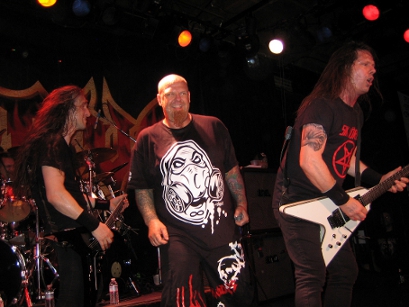
14. Hell’s Breath (Let There be Blood, 2009). Before Hell’s Breath RD said, “(Chris) Kontos [former Exodus drummer] where are you? This one is for you. You are the star of the DVD (Shovel Headed Tour Machine: Live at Wacken and Other Assorted Atrocities). Seeing you 15 feet above ground. [RD erroneously identified Chris Kontos when he meant Toby Rage whose photograph mid air high atop the crowd is featured on the DVD.] This one is called Hell’s Breath.” Hell’s Breath featured mid tempo chugging guitar riffs. RD sang the first two verses and choruses in standard verse chorus pattern. The band experienced minor technical difficulties that thrice caused very loud feedback from GH and LA’s Engl amps. Since RD was standing one foot in front of the amps, he covered his ears as he sang and stormed back and forth while he covered his ears. [RD reminded me of Quasimodo, the namesake in Victor Hugo’s novel, “The Hunchback of Notre Dame” (1831) because he hunched over as he stormed back and forth, the difference being Quasimodo became deaf from loud ringing of church bells whereas RD nearly became deaf from amp feedback.] As RD screamed the chorus the song shifted to an up tempo mode with TH exhibiting unbelievable drumming. GH and LA each played 10 second guitar solos followed by a 60 second jam session. RD then sang the third and final verse. After the song concluded RD asked, “How many people saw that song back in the day? (numerous audience members raised their hands) Wow!”
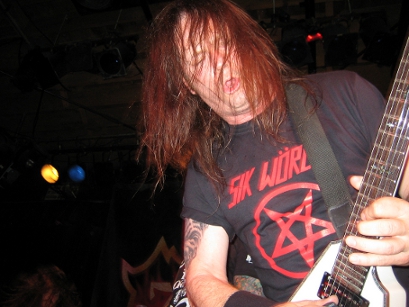
15. Toxic Waltz (Fabulous Disaster, 1989). Before Toxic Waltz RD said, “You guys tired? We got time for a couple more. I want to see an old school fu**in’ pit for The Toxic Fu**in’ Waltz!” Toxic Waltz is a mid tempo song with a catchy melody during the verses, pre chorus, and chorus. RD sang the first verse in pseudo rap fashion and fluidly transitioned to the pre chorus and chorus. After a two second interlude RD sang the second verse, pre chorus and chorus. GH and LA switched back and forth each playing two guitar solos lasting 60 seconds followed by a 25 second jam session. The tempo slightly slowed down before RD sang the third and final verse. Toxic Waltz is arguably the band’s biggest commercial hit mainly due to the airplay its video received on Headbanger’s Ball (MTV television program consisting of heavy metal music videos).
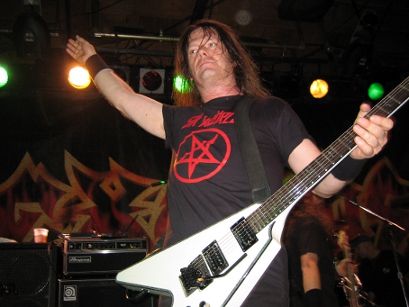
16. Good Riddance (Exhibit B: The Human Condition, 2010). Before Good Riddance RD said, “Everybody say hello to Gary Holt, Jack Gibson, Lee Fu**in’ Altus, and, on the drums, Tom Fu**in’ Hunting! Give it up for Heathen. Lee Altus pulled double duty. He did that for you.” RD sang the first verse of this up tempo thrasher at a particularly fast pace followed by the first chorus. During the 35 second interlude between the first chorus and second verse GH and LA played a flurry of muted guitar riffs while TH played frenetic double bass drums. After the second verse GH and LA played frenetic riffs for 20 seconds followed by guitar solos for 40 seconds. RD stood next to LA during his guitar solo and played air guitar complete with wincing. RD then sang the third verse and second chorus. The band members individually came stage front and raised their hands in appreciation.
Venue: Slim’s is a 400 seat San Francisco club that rhythm and blues artist Boz Scaggs opened in 1988. Slim’s is located within three miles of San Francisco’s financial district. The club decor is simple and includes chandeliers, brick walls, and a bar inspired by the facades of New Orleans manors. Within five feet of walking through the entrance are six steps that lead immediately up and into the general admission floor approximately 20 feet from the stage. At one end of the main floor is the stage that measures 29 feet wide by 16 feet deep. The stage is three feet and three inches from the club floor and features a moveable drum riser eight feet by six feet and a very narrow photo pit. At the other end of the main floor is a small balcony with 14 tables and seating for 70 people. The sound console is located in the rear by the steps leading up to the balcony. The L shaped bar runs the length of the floor stage left. The general admission floor also includes six pillars. Located downstairs are three dressing rooms, coat check, and additional restrooms.
Opening Bands (first to last): Passive Aggressive, Anvil Chorus, Heathen
Arash Moussavian, Entertainment Law Attorney
arashmoussavian@cal.berkeley.edu
http://www.linkedin.com/in/arashmoussavian
All photos taken by Arash Moussavian. This article and all photos are protected by copyright. Please contact me prior to use, or I will make shish kabab of your loins.
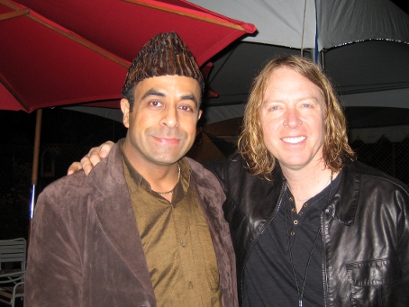
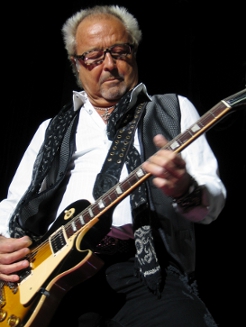 1. Double Vision (Double Vision record, 1978) is a mid tempo song that began with Mick Jones’s (“MJ’s,” lead guitarist) catchy guitar chord progression and run. MJ wore black Converse sneakers, black jean pants, long sleeve white cotton shirt with vertical satin stripes, black scarf with an intermittent white pattern, and black vest with very fine white polka dots minimally spaced from one another that gave the vest a grey appearance from afar. [As I stood in the photo pit three feet from MJ I was impressed by his dapper state. MJ had a golden tan George Hamilton (American film and television actor) would envy. MJ’s fingernails were finely manicured as if he was about to attend a knighting ceremony by Queen Elizabeth II, and his moustache and goatee were so neatly trimmed his stylist must have used a diamond measuring magnifier.] Immediately before Kelly Hansen (“KH,” lead vocalist) sang the first verse, at approximately the 0:15 mark (approximations presumed throughout), Brian Sutter (“BS,” drummer) played a series of drum fills. The first and second verses featured MJ and Thom Gimbel’s (“TG’s,” rhythm guitarist, saxophonist) chugging guitar chord progressions and Jeff Pilson’s (“JP’s,” bassist) trudging bass lines. During the first and second choruses the tempo slightly slowed down and prominently featured Michael Bluestein’s (“MB’s,” keyboardist) keyboard notes. The tempo escalated and resumed a mid tempo pace when KH sang the last line of the choruses, “My double vision gets the best of me.” During the last 60 seconds of the song the band sang the third chorus.
1. Double Vision (Double Vision record, 1978) is a mid tempo song that began with Mick Jones’s (“MJ’s,” lead guitarist) catchy guitar chord progression and run. MJ wore black Converse sneakers, black jean pants, long sleeve white cotton shirt with vertical satin stripes, black scarf with an intermittent white pattern, and black vest with very fine white polka dots minimally spaced from one another that gave the vest a grey appearance from afar. [As I stood in the photo pit three feet from MJ I was impressed by his dapper state. MJ had a golden tan George Hamilton (American film and television actor) would envy. MJ’s fingernails were finely manicured as if he was about to attend a knighting ceremony by Queen Elizabeth II, and his moustache and goatee were so neatly trimmed his stylist must have used a diamond measuring magnifier.] Immediately before Kelly Hansen (“KH,” lead vocalist) sang the first verse, at approximately the 0:15 mark (approximations presumed throughout), Brian Sutter (“BS,” drummer) played a series of drum fills. The first and second verses featured MJ and Thom Gimbel’s (“TG’s,” rhythm guitarist, saxophonist) chugging guitar chord progressions and Jeff Pilson’s (“JP’s,” bassist) trudging bass lines. During the first and second choruses the tempo slightly slowed down and prominently featured Michael Bluestein’s (“MB’s,” keyboardist) keyboard notes. The tempo escalated and resumed a mid tempo pace when KH sang the last line of the choruses, “My double vision gets the best of me.” During the last 60 seconds of the song the band sang the third chorus.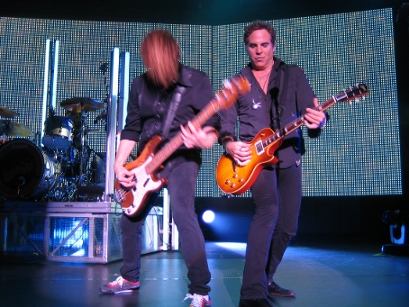
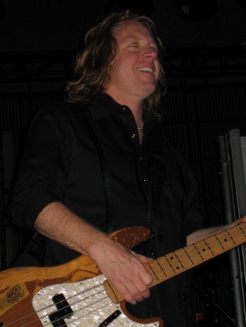 3. Cold As Ice (Foreigner, 1977) began with MJ playing a very recognizable keyboard chord progression atop a keyboard riser positioned stage right. Ten seconds into the song MJ’s keyboard notes were augmented by BS’s snare and tom tom drums and continued into the first verse as KH sang, “You’re as cold as ice. You’re willing to sacrifice our love. You never take advice. Someday you’ll pay the price … I know.” KH then sang the first chorus that included a 15 second segment during which the tempo slightly slowed down and the tone became more commercial as KH sang, “I’ve seen it before, it happens all the time (ooh-ooh). You’re closing the door, you leave the world behind. You’re digging for gold, you’re throwing away (aah-aah). A fortune in feelings, but someday you’ll pay.” The commercial tone was largely attributed to MB’s “ooh-ooh” and “aah-aah” contributions. KH then sang the second verse that contained slightly varied lyrics from the first verse and was followed by TG’s 10 second guitar solo. The band then exchanged a melodic series of vocal lines, “Cold as ice. You know that you are. Cold as ice. As cold as ice to me. Cold as ice.” MB, TG, and JP sang the phrase, “Cold as ice” while KH sang the remainder. The tempo slightly escalated as the band repeated the phrase, “Cold as ice. You’re as cold as ice, cold as ice, I know.”
3. Cold As Ice (Foreigner, 1977) began with MJ playing a very recognizable keyboard chord progression atop a keyboard riser positioned stage right. Ten seconds into the song MJ’s keyboard notes were augmented by BS’s snare and tom tom drums and continued into the first verse as KH sang, “You’re as cold as ice. You’re willing to sacrifice our love. You never take advice. Someday you’ll pay the price … I know.” KH then sang the first chorus that included a 15 second segment during which the tempo slightly slowed down and the tone became more commercial as KH sang, “I’ve seen it before, it happens all the time (ooh-ooh). You’re closing the door, you leave the world behind. You’re digging for gold, you’re throwing away (aah-aah). A fortune in feelings, but someday you’ll pay.” The commercial tone was largely attributed to MB’s “ooh-ooh” and “aah-aah” contributions. KH then sang the second verse that contained slightly varied lyrics from the first verse and was followed by TG’s 10 second guitar solo. The band then exchanged a melodic series of vocal lines, “Cold as ice. You know that you are. Cold as ice. As cold as ice to me. Cold as ice.” MB, TG, and JP sang the phrase, “Cold as ice” while KH sang the remainder. The tempo slightly escalated as the band repeated the phrase, “Cold as ice. You’re as cold as ice, cold as ice, I know.”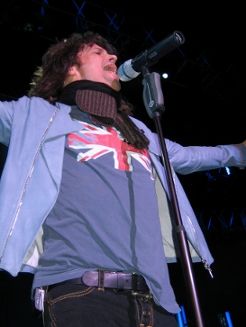 5. Dirty White Boy (Head Games, 1979). Before Dirty White Boy KH said, “How many naughty girls do we have out there? (screams from female audience members) That’s perfect because I am a Dirty White Boy.” KH wore white sneakers, tight navy blue jean pants, navy blue t shirt with Union Jack logo, black scarf with brown and black vertical stripes on its ends, and powder blue leather jacket. [KH comes from the Mick Jagger school of rock, not only in terms of some stage moves, but also his lanky frame and prominent mouth.] Dirty White Boy is an up tempo song that began with a catchy, bluesy MJ guitar riff reminiscent of B.B. King (black American blues guitarist, singer) that he continued to play into the first verse. When KH transitioned from the first verse to the first chorus the tempo slightly escalated. The first chorus began and ended with BS’s rapid drum fills and also featured JP’s punchy bass lines as KH sang, “’Cause I’m a dirty white boy. Yeah a dirty white boy. A dirty white boy.” The phrase “Dirty White Boy” repeatedly flashed in white letters against a black background on the video screen that stretched to the ends of the large stage. The video screen was comprised of 44 rectangular shaped panels mounted in two rows, each containing 22 panels. During the second verse the tempo slightly slowed down and prominently featured MB’s keyboard chords. MJ then played a fiery, fluid 20 second guitar solo on his black Gibson Les Paul that concluded with harmonic notes. The band then sang the third chorus followed by the third verse that featured two memorable MJ guitar runs. During the last 60 seconds of the song the band thrice repeated the chorus. Dirty White Boy and another song to be performed received the strongest audience reaction.
5. Dirty White Boy (Head Games, 1979). Before Dirty White Boy KH said, “How many naughty girls do we have out there? (screams from female audience members) That’s perfect because I am a Dirty White Boy.” KH wore white sneakers, tight navy blue jean pants, navy blue t shirt with Union Jack logo, black scarf with brown and black vertical stripes on its ends, and powder blue leather jacket. [KH comes from the Mick Jagger school of rock, not only in terms of some stage moves, but also his lanky frame and prominent mouth.] Dirty White Boy is an up tempo song that began with a catchy, bluesy MJ guitar riff reminiscent of B.B. King (black American blues guitarist, singer) that he continued to play into the first verse. When KH transitioned from the first verse to the first chorus the tempo slightly escalated. The first chorus began and ended with BS’s rapid drum fills and also featured JP’s punchy bass lines as KH sang, “’Cause I’m a dirty white boy. Yeah a dirty white boy. A dirty white boy.” The phrase “Dirty White Boy” repeatedly flashed in white letters against a black background on the video screen that stretched to the ends of the large stage. The video screen was comprised of 44 rectangular shaped panels mounted in two rows, each containing 22 panels. During the second verse the tempo slightly slowed down and prominently featured MB’s keyboard chords. MJ then played a fiery, fluid 20 second guitar solo on his black Gibson Les Paul that concluded with harmonic notes. The band then sang the third chorus followed by the third verse that featured two memorable MJ guitar runs. During the last 60 seconds of the song the band thrice repeated the chorus. Dirty White Boy and another song to be performed received the strongest audience reaction.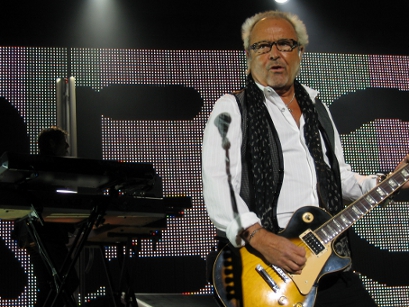
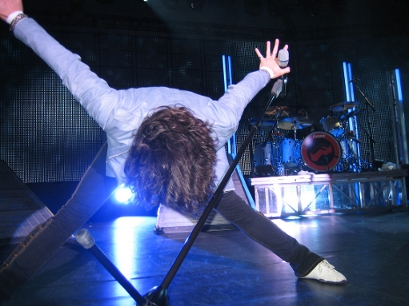
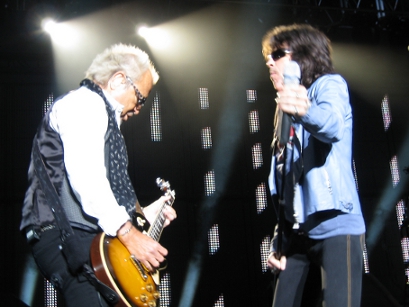
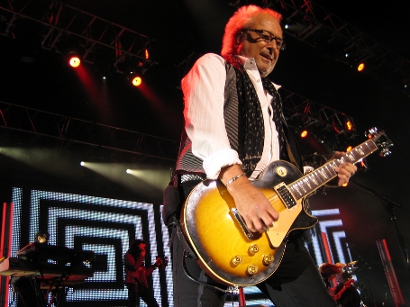
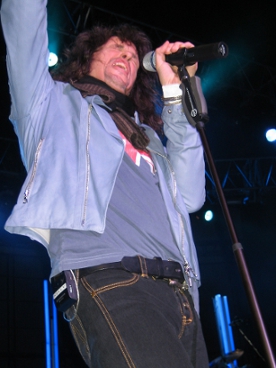 9. Urgent (4, 1981). Urgent was preceded by a two minute jam session featuring MJ, MB, and BS. KH then appeared center stage and said, “All right! On your feet! You know why? Because it’s Urgent!” [I knew why it was urgent to get on my feet. I had to use the restroom to “powder my nose” but refrained until after the set.] Urgent began with MJ’s loose guitar notes, JP’s punchy bass lines, and BS’s steady drum beats augmented by a dizzying array of flashing colors on the video screen. The audience responded with loud cheers and most of those seated stood up. [I felt as if I was amidst a Sunday church sermon in the Deep South presided by James Brown (American singer, entertainer dubbed “The Godfather of Soul”).] KH sang the first three verses at a mid tempo pace. KH then sang the first chorus while the word “Urgent” repeatedly flashed on the video screen. [Not a good thing for my exploding bladder.] While KH sang the final line of the first chorus TG played a five second saxophone (“sax”) melody standing on the ramp next to BS. TG wore black leather shoes, black jean pants, and long sleeve black cotton shirt. TG primarily played a maple Gibson Les Paul and donned sunglasses for his sax solo. KH then sang the fourth and fifth verses that prominently featured MB’s keyboards. After the second chorus TG stood center stage and played an entertaining 50 second sax solo augmented by JP’s punchy bass lines and MB’s keyboards. During TG’s sax solo MJ stood on the ramp next to BS while KH stood on the ramp next to MB and played a cowbell. Midway through TG’s solo KH and JP switched places on the ramp. TG played the high sax notes on his knees. During the last 60 seconds of the song KH sang the third chorus. When Urgent concluded KH said, “Let’s hear it for Thom Gimbel on the sax.” [TG is a talented musician but has an amusing habit. When playing the guitar, particularly when hitting a high note during a solo or striking a heavy chord, TG often exhibits a blend of a smirk and a grimace. It’s as if he cannot make up his mind between being mischievous or macho, confusing my walnut sized brain.]
9. Urgent (4, 1981). Urgent was preceded by a two minute jam session featuring MJ, MB, and BS. KH then appeared center stage and said, “All right! On your feet! You know why? Because it’s Urgent!” [I knew why it was urgent to get on my feet. I had to use the restroom to “powder my nose” but refrained until after the set.] Urgent began with MJ’s loose guitar notes, JP’s punchy bass lines, and BS’s steady drum beats augmented by a dizzying array of flashing colors on the video screen. The audience responded with loud cheers and most of those seated stood up. [I felt as if I was amidst a Sunday church sermon in the Deep South presided by James Brown (American singer, entertainer dubbed “The Godfather of Soul”).] KH sang the first three verses at a mid tempo pace. KH then sang the first chorus while the word “Urgent” repeatedly flashed on the video screen. [Not a good thing for my exploding bladder.] While KH sang the final line of the first chorus TG played a five second saxophone (“sax”) melody standing on the ramp next to BS. TG wore black leather shoes, black jean pants, and long sleeve black cotton shirt. TG primarily played a maple Gibson Les Paul and donned sunglasses for his sax solo. KH then sang the fourth and fifth verses that prominently featured MB’s keyboards. After the second chorus TG stood center stage and played an entertaining 50 second sax solo augmented by JP’s punchy bass lines and MB’s keyboards. During TG’s sax solo MJ stood on the ramp next to BS while KH stood on the ramp next to MB and played a cowbell. Midway through TG’s solo KH and JP switched places on the ramp. TG played the high sax notes on his knees. During the last 60 seconds of the song KH sang the third chorus. When Urgent concluded KH said, “Let’s hear it for Thom Gimbel on the sax.” [TG is a talented musician but has an amusing habit. When playing the guitar, particularly when hitting a high note during a solo or striking a heavy chord, TG often exhibits a blend of a smirk and a grimace. It’s as if he cannot make up his mind between being mischievous or macho, confusing my walnut sized brain.]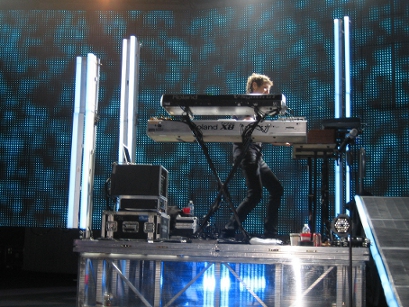
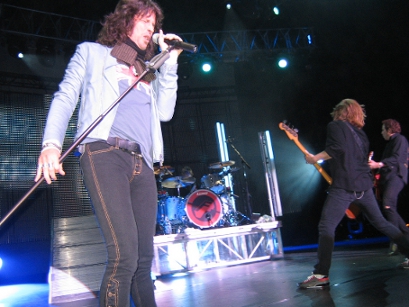
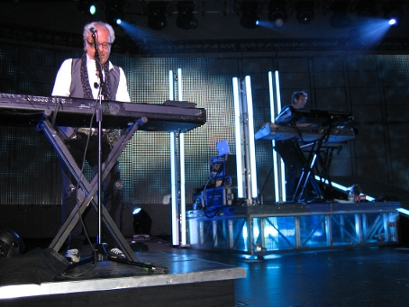
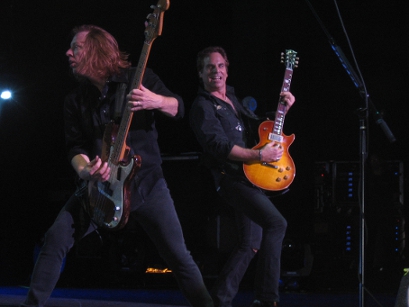
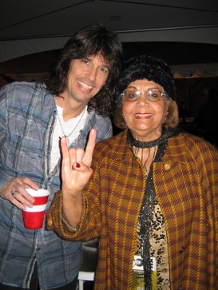 Venue: Concord Pavilion (“CP”) is an outdoor ampitheater built in 1975 and designed by Pritzker Prize-winning architect Frank Gehry and landscape architect Peter Walker. Gehry also designed the Guggenheim Museum in Bilbao, Spain and the Walt Disney Concert Hall in Los Angeles, California. CP was built in response to the East Bay community’s desire to have a venue for the annual Concord Summer Festival. CP is set in a natural bowl below Mt. Diablo. CP was remodeled in 1996 to increase seating and make additional improvements. CP has a 12,500 seat capacity comprised of (1) three tiered seated sections and (2) perimeter lawn section. For a period of time Concord Pavilion was called the Chronicle Pavilion, and it is currently called the Sleep Train Pavilion, both corporate entities that purchased naming rights.
Venue: Concord Pavilion (“CP”) is an outdoor ampitheater built in 1975 and designed by Pritzker Prize-winning architect Frank Gehry and landscape architect Peter Walker. Gehry also designed the Guggenheim Museum in Bilbao, Spain and the Walt Disney Concert Hall in Los Angeles, California. CP was built in response to the East Bay community’s desire to have a venue for the annual Concord Summer Festival. CP is set in a natural bowl below Mt. Diablo. CP was remodeled in 1996 to increase seating and make additional improvements. CP has a 12,500 seat capacity comprised of (1) three tiered seated sections and (2) perimeter lawn section. For a period of time Concord Pavilion was called the Chronicle Pavilion, and it is currently called the Sleep Train Pavilion, both corporate entities that purchased naming rights.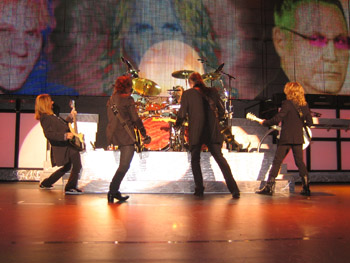
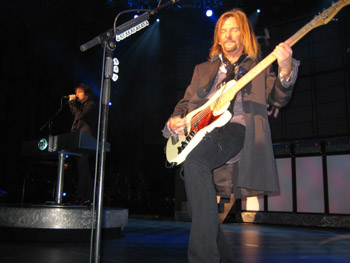
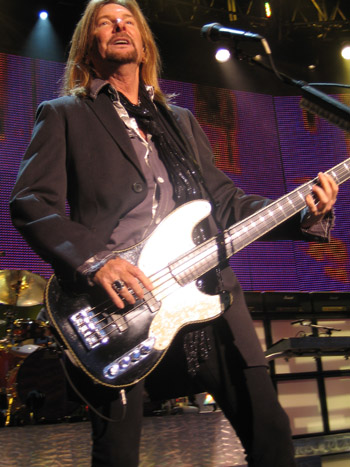
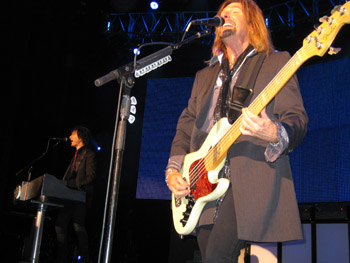
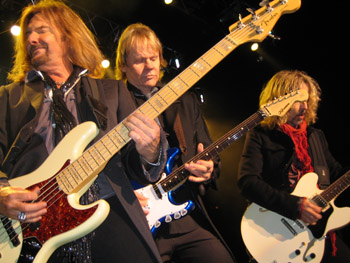

 2. Unleashing the Bloodthirsty (Bloodthirst, 1999) is a fairly slow tempo song with an ominous brooding feel. PO, RB, and PM’s verse riffs gave the song a chugging, groovy feel. The tempo slightly slowed down when GF twice repeated the chorus, “Blood. They live, they thirst. Blood.” GF emphasized the first and last words by screaming, “Blooooooood.” The tempo significantly increased when GF sang the third verse, “First one that they find. Attack the mortal. Claws tear at his face. Pull the flesh from bone. Decapitate the man. They hold his head aloft. Headless body slumps. The blood is gushing out. Screaming victims fall. Repulsive beasts attack. Gore pours from the torso. Hellish creatures stab. Organs, grisly trophies. Rewards for their rage. Blood drips from their jaws. They disembowel the corpse.” The third chorus differed from the first two because GF sang, “Kill with speed. Victims bleed. Wretched souls. Headless on poles. (five second pause) Savage thirst. Vessels burst. Torn apart. Eat the heart.” Following the third verse RB and PO traded guitar solos for 15 seconds. PO, RB, AW, and PM then jammed for 10 seconds, leading back to the first two choruses that featured a fairly slow tempo.
2. Unleashing the Bloodthirsty (Bloodthirst, 1999) is a fairly slow tempo song with an ominous brooding feel. PO, RB, and PM’s verse riffs gave the song a chugging, groovy feel. The tempo slightly slowed down when GF twice repeated the chorus, “Blood. They live, they thirst. Blood.” GF emphasized the first and last words by screaming, “Blooooooood.” The tempo significantly increased when GF sang the third verse, “First one that they find. Attack the mortal. Claws tear at his face. Pull the flesh from bone. Decapitate the man. They hold his head aloft. Headless body slumps. The blood is gushing out. Screaming victims fall. Repulsive beasts attack. Gore pours from the torso. Hellish creatures stab. Organs, grisly trophies. Rewards for their rage. Blood drips from their jaws. They disembowel the corpse.” The third chorus differed from the first two because GF sang, “Kill with speed. Victims bleed. Wretched souls. Headless on poles. (five second pause) Savage thirst. Vessels burst. Torn apart. Eat the heart.” Following the third verse RB and PO traded guitar solos for 15 seconds. PO, RB, AW, and PM then jammed for 10 seconds, leading back to the first two choruses that featured a fairly slow tempo. 4. Sentenced to Burn (Gallery of Suicide, 1998) is an up tempo song that featured PO, RB, and AW’s chugging riffs. From the 0:15 to 1:05 marks GF sang the 40 lines of the first verse in rapid succession and emphasized the final word of the last verse, “They will all dieeeeeeee.” After the first chorus PO played a five second guitar run. When GF sang the second chorus he screamed the final word, “Pile the bodies. Set them aflame. The human race. Sentenced to burrrrrrrrn.” From the 2:05 to 2:15 marks PO and RB played riffs with harmonies, which was followed by PO’s 15 second guitar solo. PO wore a black T-shirt with an unidentifiable band’s name, black cargo cotton slacks, and black combat boots. PO played a black B.C. Rich Custom V guitar and used Mesa Boogie amplifiers (“amps”).
4. Sentenced to Burn (Gallery of Suicide, 1998) is an up tempo song that featured PO, RB, and AW’s chugging riffs. From the 0:15 to 1:05 marks GF sang the 40 lines of the first verse in rapid succession and emphasized the final word of the last verse, “They will all dieeeeeeee.” After the first chorus PO played a five second guitar run. When GF sang the second chorus he screamed the final word, “Pile the bodies. Set them aflame. The human race. Sentenced to burrrrrrrrn.” From the 2:05 to 2:15 marks PO and RB played riffs with harmonies, which was followed by PO’s 15 second guitar solo. PO wore a black T-shirt with an unidentifiable band’s name, black cargo cotton slacks, and black combat boots. PO played a black B.C. Rich Custom V guitar and used Mesa Boogie amplifiers (“amps”).
 7. Pounded Into Dust (Bloodthirst, 1999). Before Pounded Into Dust GF said, “Well I know everybody out there has someone in their lives whose head you want to bash in. But you shouldn’t do that because it will get you into jail. Instead take your aggression out in the pit.” Pounded Into Dust is a fairly fast tempo two minute song. GF sang the first two verses in fairly rapid fashion as if comprised of run on sentences, “Forces of hate meet. Gather for the siege. Encircling their foe. The raid begins. Their revenge is sought. Through violence, smashing, killing, stabbing, pounding. Iron weapons clash. Evil warriors strike. Hammers cracking skulls. Axes chopping heads. Their revenge is now. Through violence, smashing, killing, stabbing, pounding.” GF then sang the first chorus during which he emphasized the final word and drew it out with much audience participation, “Blood soaks the ground. In their own, they will drown. Surrounded by disgust. Pounded into duuuuuuuust.” After the third verse PO played a five second solo. GF then sang the third and final chorus.
7. Pounded Into Dust (Bloodthirst, 1999). Before Pounded Into Dust GF said, “Well I know everybody out there has someone in their lives whose head you want to bash in. But you shouldn’t do that because it will get you into jail. Instead take your aggression out in the pit.” Pounded Into Dust is a fairly fast tempo two minute song. GF sang the first two verses in fairly rapid fashion as if comprised of run on sentences, “Forces of hate meet. Gather for the siege. Encircling their foe. The raid begins. Their revenge is sought. Through violence, smashing, killing, stabbing, pounding. Iron weapons clash. Evil warriors strike. Hammers cracking skulls. Axes chopping heads. Their revenge is now. Through violence, smashing, killing, stabbing, pounding.” GF then sang the first chorus during which he emphasized the final word and drew it out with much audience participation, “Blood soaks the ground. In their own, they will drown. Surrounded by disgust. Pounded into duuuuuuuust.” After the third verse PO played a five second solo. GF then sang the third and final chorus. From the 2:15 to 2:30 marks PO, RB, AW, and PM engaged in a frenetic jam immediately followed by GF screaming, “Scion of the murders. A bloodline so profane. Born insane. Predestined to annihilate. Through sinister eugenics. Sworn to kill, they will.” As GF sang the final line the tempo drastically decreased. The tempo gradually increased as GF screamed, “It was made to kill!” GF then played air drums in unison with PM’s bass drums and engaged in his signature headbanging, firmly grasping his microphone with his right hand, resting his left hand on his thigh, and rapidly rotating his head bent forward in sweeping clockwise fashion. All that was visible of GF’s head was a long mane of auburn hair swirling around like a whirling dervish. AW joined GF in rotating his head while masterfully performing three-finger string plucking. PO and RB traded guitar solos for 15 seconds. The Wretched Spawn led straight into Gutted.
From the 2:15 to 2:30 marks PO, RB, AW, and PM engaged in a frenetic jam immediately followed by GF screaming, “Scion of the murders. A bloodline so profane. Born insane. Predestined to annihilate. Through sinister eugenics. Sworn to kill, they will.” As GF sang the final line the tempo drastically decreased. The tempo gradually increased as GF screamed, “It was made to kill!” GF then played air drums in unison with PM’s bass drums and engaged in his signature headbanging, firmly grasping his microphone with his right hand, resting his left hand on his thigh, and rapidly rotating his head bent forward in sweeping clockwise fashion. All that was visible of GF’s head was a long mane of auburn hair swirling around like a whirling dervish. AW joined GF in rotating his head while masterfully performing three-finger string plucking. PO and RB traded guitar solos for 15 seconds. The Wretched Spawn led straight into Gutted.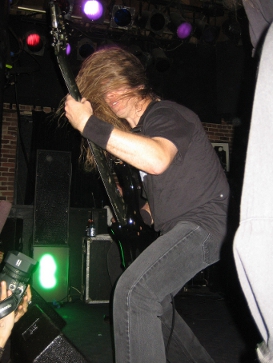 10. Evisceration Plague (Evisceration Plague, 2009). Before Evisceration Plague the audience began a well deserved homage during which they repeatedly chanted, “George.” GF responded by saying, “Thank you. That is awesome. We have a new album. It has been out for a while. You should have it or I will find you and kill you. Some of you sick mother f**kers will like that.” Evisceration Plague is a mid tempo song. For the first 35 seconds PO and RB played a chugging, brooding riff amidst green stage lights. Between each verse PO played a searing 10 second guitar run atop RB’s ominous riffs. During the catchy chorus GF sang, “Beg for your life, you won’t escape the knife. Your fate was sealed today. Disease will spread, you pray for death. Evisceration plague.” PM’s bass drums and the audience’s repeated chant of “Hoy!” augmented the chorus. At the end of the third verse, while PB frantically struck his bass drums, GF sang, “My entrails are in my hands (sung two times). Plague leads to death (sung four times).” PO then played a 25 second guitar solo. The signature aspect of Evisceration Plague is how its melody featured by GF’s singing, PO and RB’s riffs, and PB’s drumming all presented a united front creating an evil wall of sound that compelled the audience to bang their heads.
10. Evisceration Plague (Evisceration Plague, 2009). Before Evisceration Plague the audience began a well deserved homage during which they repeatedly chanted, “George.” GF responded by saying, “Thank you. That is awesome. We have a new album. It has been out for a while. You should have it or I will find you and kill you. Some of you sick mother f**kers will like that.” Evisceration Plague is a mid tempo song. For the first 35 seconds PO and RB played a chugging, brooding riff amidst green stage lights. Between each verse PO played a searing 10 second guitar run atop RB’s ominous riffs. During the catchy chorus GF sang, “Beg for your life, you won’t escape the knife. Your fate was sealed today. Disease will spread, you pray for death. Evisceration plague.” PM’s bass drums and the audience’s repeated chant of “Hoy!” augmented the chorus. At the end of the third verse, while PB frantically struck his bass drums, GF sang, “My entrails are in my hands (sung two times). Plague leads to death (sung four times).” PO then played a 25 second guitar solo. The signature aspect of Evisceration Plague is how its melody featured by GF’s singing, PO and RB’s riffs, and PB’s drumming all presented a united front creating an evil wall of sound that compelled the audience to bang their heads.
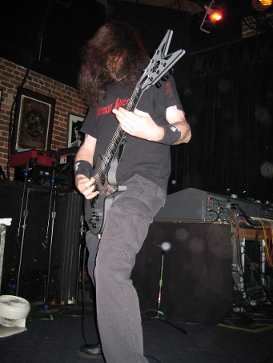 13. Make Them Suffer (Kill, 2006). Before Make Them Suffer the white stage lights shined on the crowd and GF said, “I want to see a really big pit for this song. If you see someone out there playing with their di*ks or playing with their girlfriend’s ti*s, tell them to do that on their own time. This is OUR time. Throw them in the pit and Make Them Suffer!” Make Them Suffer is a very frenetic song that, at the 0:10 mark, featured GF scream, “Suffeeeeeeeer!” Between the second and third verses PO and RB played a dizzying array of complicated riffs augmented by PM’s driving bass and tom tom drums. [RB moved his left hand so quickly across the fretboard it resembled a hummingbird’s wings in mid flight.] RB wore an Infernal Majesty (thrash band from Toronto, Canada) black T-shirt, black cargo cotton pants, black boots, and black wristbands on both wrists. RB primarily played a grey Dean guitar with black trim and sparingly played a black Dean guitar with red trim. RB used Mesa Boogie amps. PO, RB, and AW played the same melody GF sang during the first chorus. GF twice sang the chorus before and after PO played a 10 second guitar solo amidst the battery of PM’s bass drums. The lyrics for each chorus slightly varied. For the first chorus GF sang, “Make them suffer while they plead for cessation. Entirely demoralized and close to mass extinction. Damned to please supremacy. The reason for their martyrdom they will never know.” GF thrice repeated the phrase, “Make them suffer” before singing the second part of the chorus, “Make them suffer while they bleed through damnation. Begged for retribution before meeting with demise. Cursed by animosity. Once chosen for this mad ordeal there is no escape.” Make Them Suffer was the most technically proficient song the band performed.
13. Make Them Suffer (Kill, 2006). Before Make Them Suffer the white stage lights shined on the crowd and GF said, “I want to see a really big pit for this song. If you see someone out there playing with their di*ks or playing with their girlfriend’s ti*s, tell them to do that on their own time. This is OUR time. Throw them in the pit and Make Them Suffer!” Make Them Suffer is a very frenetic song that, at the 0:10 mark, featured GF scream, “Suffeeeeeeeer!” Between the second and third verses PO and RB played a dizzying array of complicated riffs augmented by PM’s driving bass and tom tom drums. [RB moved his left hand so quickly across the fretboard it resembled a hummingbird’s wings in mid flight.] RB wore an Infernal Majesty (thrash band from Toronto, Canada) black T-shirt, black cargo cotton pants, black boots, and black wristbands on both wrists. RB primarily played a grey Dean guitar with black trim and sparingly played a black Dean guitar with red trim. RB used Mesa Boogie amps. PO, RB, and AW played the same melody GF sang during the first chorus. GF twice sang the chorus before and after PO played a 10 second guitar solo amidst the battery of PM’s bass drums. The lyrics for each chorus slightly varied. For the first chorus GF sang, “Make them suffer while they plead for cessation. Entirely demoralized and close to mass extinction. Damned to please supremacy. The reason for their martyrdom they will never know.” GF thrice repeated the phrase, “Make them suffer” before singing the second part of the chorus, “Make them suffer while they bleed through damnation. Begged for retribution before meeting with demise. Cursed by animosity. Once chosen for this mad ordeal there is no escape.” Make Them Suffer was the most technically proficient song the band performed.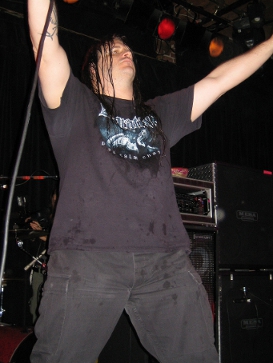 14. Priests of Sodom (Evisceration Plague, 2009). Before Priests of Sodom GF said, “Time to send out a very special dedication. This song is going out to all the women. It’s not the song you think it is. This song goes out to the ladies, but a special kind of lady. It goes out to the sluts out there. (female fans screamed in delight) Priests of Sodom.” Priests of Sodom is an up tempo song that began amidst GF’s scream, AW’s galloping, heavy bass lines, and PM’s pummeling snare and bass drums. The verses have an interesting twist in that GF repeated the even numbered verse lines to which he added an introductory phrase (e.g., “you must,” “there is”), “The blackened city calls out. Enter the temple of sin. You must enter the temple of sin. Contorted sinners beckon. Join our twisted rites. You must join our twisted rites. The priest’s eyes gleam. Blood on their scepters of flesh. There is blood on their scepters of flesh. The nubile virgin bows. Await the piercing thrust. She awaits the piercing thrust.” GF’s vocals were augmented by PO and RB’s chugging riffs syncopated with PM’s bass and tom tom drums. After the second chorus GF sang the verse with the most interesting lyrics, “Statues of demons glisten with sweat. The orgy intensifies violence begins. Flagellate sluts with serpentine whips. They raise their blades to throats of their men. Climax approaches and the blood will spill. Sexual sacrifice, mutilation and death.” After this verse GF shouted and repeated five times, “Murderrrrrrrr … Priest of sodom.” PO played a 20 second guitar solo after which GR sang the final chorus amidst the torrent of PM’s bass drums, “Perverse rites. Priests of sodom preside. We are damned. Immortal lust. Wicked legions come forth. Defile the pure.”
14. Priests of Sodom (Evisceration Plague, 2009). Before Priests of Sodom GF said, “Time to send out a very special dedication. This song is going out to all the women. It’s not the song you think it is. This song goes out to the ladies, but a special kind of lady. It goes out to the sluts out there. (female fans screamed in delight) Priests of Sodom.” Priests of Sodom is an up tempo song that began amidst GF’s scream, AW’s galloping, heavy bass lines, and PM’s pummeling snare and bass drums. The verses have an interesting twist in that GF repeated the even numbered verse lines to which he added an introductory phrase (e.g., “you must,” “there is”), “The blackened city calls out. Enter the temple of sin. You must enter the temple of sin. Contorted sinners beckon. Join our twisted rites. You must join our twisted rites. The priest’s eyes gleam. Blood on their scepters of flesh. There is blood on their scepters of flesh. The nubile virgin bows. Await the piercing thrust. She awaits the piercing thrust.” GF’s vocals were augmented by PO and RB’s chugging riffs syncopated with PM’s bass and tom tom drums. After the second chorus GF sang the verse with the most interesting lyrics, “Statues of demons glisten with sweat. The orgy intensifies violence begins. Flagellate sluts with serpentine whips. They raise their blades to throats of their men. Climax approaches and the blood will spill. Sexual sacrifice, mutilation and death.” After this verse GF shouted and repeated five times, “Murderrrrrrrr … Priest of sodom.” PO played a 20 second guitar solo after which GR sang the final chorus amidst the torrent of PM’s bass drums, “Perverse rites. Priests of sodom preside. We are damned. Immortal lust. Wicked legions come forth. Defile the pure.”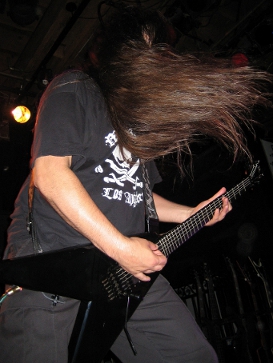 15. Staring Through the Eyes of the Dead (The Bleeding, 1994). The band briefly paused after Priests of Sodom during which GF growled, “Staring Through the Eyes of the Dead.” From the 0:30 to 1:20 marks of this mid tempo song GF sang the first verse at a particularly low octave while PO and RB played a recurring, muted riff. The tempo drastically increased as GF sang the chorus, “Help me I’m not dead. Wake me from this hell. Tell me I’m alive. Dead.” The higher tempo carried into the second verse and chorus. When GF sang the final word of the second chorus (i.e., “dead” ), the tempo significantly slowed to its initial pace and the audience chanted, “Dead.” The tempo once again escalated right before PO and RB traded guitar solos for 20 seconds. Scattered Remains, Splattered Brains, Gutted, and Staring Through the Eyes of the Dead received the strongest audience reaction.
15. Staring Through the Eyes of the Dead (The Bleeding, 1994). The band briefly paused after Priests of Sodom during which GF growled, “Staring Through the Eyes of the Dead.” From the 0:30 to 1:20 marks of this mid tempo song GF sang the first verse at a particularly low octave while PO and RB played a recurring, muted riff. The tempo drastically increased as GF sang the chorus, “Help me I’m not dead. Wake me from this hell. Tell me I’m alive. Dead.” The higher tempo carried into the second verse and chorus. When GF sang the final word of the second chorus (i.e., “dead” ), the tempo significantly slowed to its initial pace and the audience chanted, “Dead.” The tempo once again escalated right before PO and RB traded guitar solos for 20 seconds. Scattered Remains, Splattered Brains, Gutted, and Staring Through the Eyes of the Dead received the strongest audience reaction.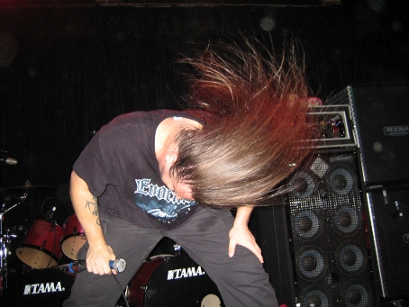
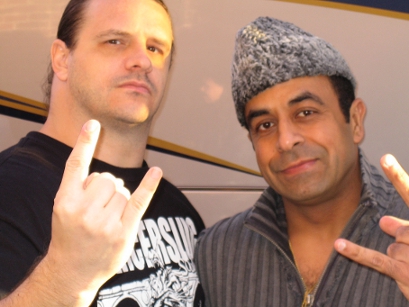
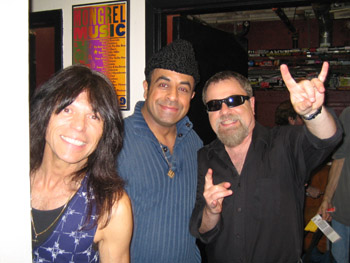
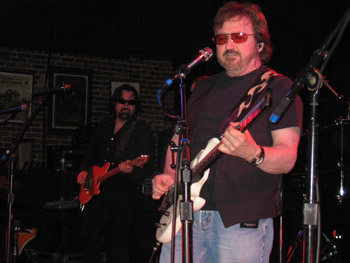
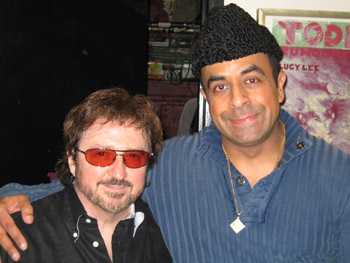
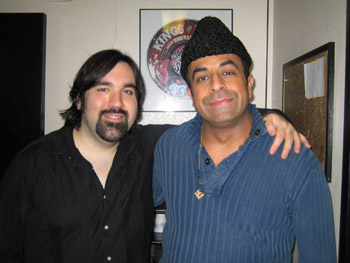
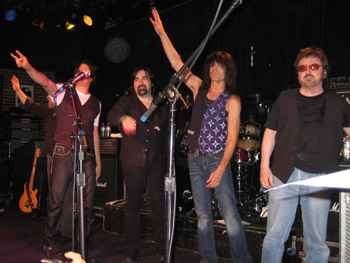
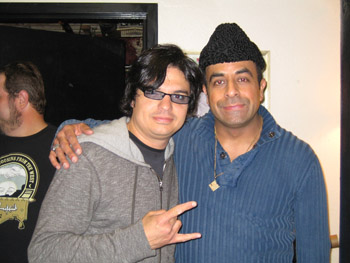

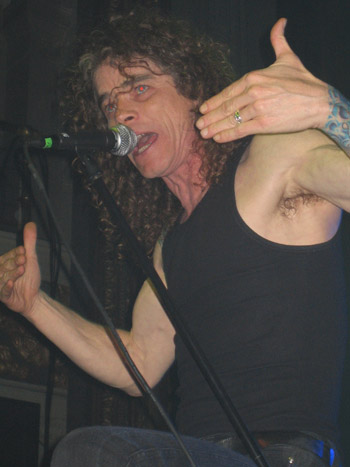
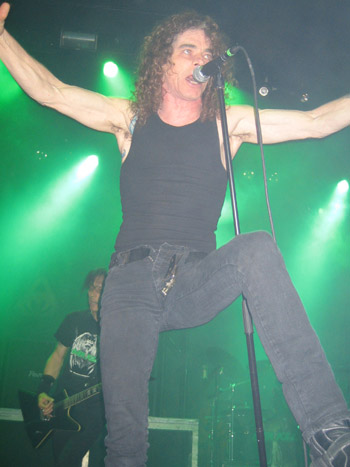
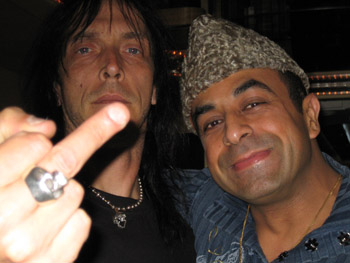
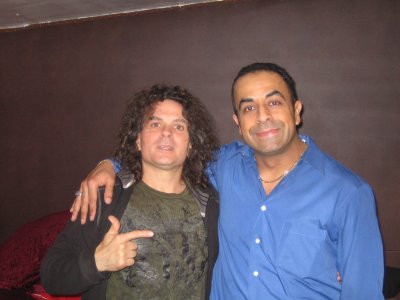
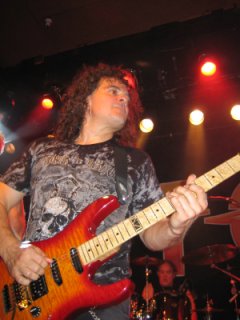
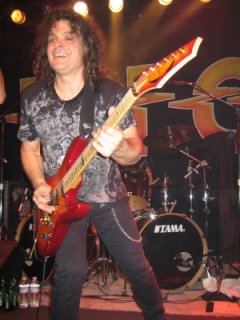
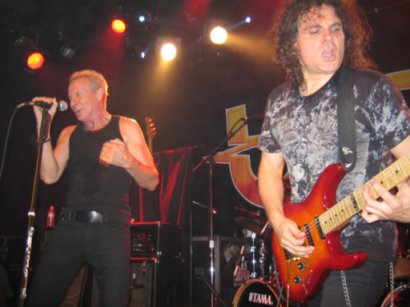
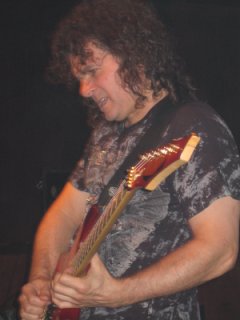
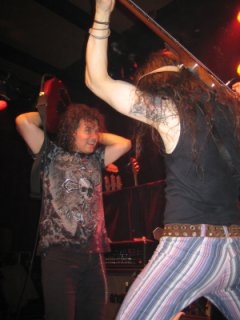
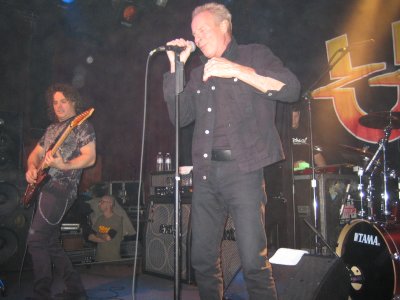
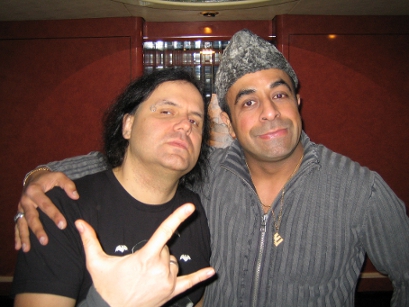
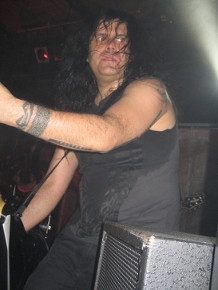 1. Choir of the Damned (Intro.) (Pleasure to Kill record, 1986) is an instrumental song that clocks in at one minute and 40 seconds. This song, which features atmospheric keyboards and acoustic guitars, served as a good introduction because it has an ominous tone.
1. Choir of the Damned (Intro.) (Pleasure to Kill record, 1986) is an instrumental song that clocks in at one minute and 40 seconds. This song, which features atmospheric keyboards and acoustic guitars, served as a good introduction because it has an ominous tone.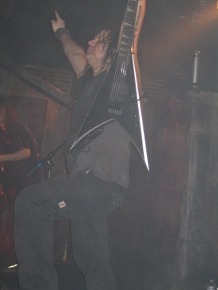 raised both his fists in the air while CG kneeled his head forward and rolled it in a clockwise fashion a la George “Corpsegrinder” Fisher (Cannibal Corpse vocalist). CG wore black jean pants and a short sleeve button down black shirt with a “Kreator” red logo and demon character on the back and a “Kreator” red logo on the left chest. CG played a black Mensinger flying V bass. At the end of the song MP raised his black flying V Jackson guitar with a white trim.
raised both his fists in the air while CG kneeled his head forward and rolled it in a clockwise fashion a la George “Corpsegrinder” Fisher (Cannibal Corpse vocalist). CG wore black jean pants and a short sleeve button down black shirt with a “Kreator” red logo and demon character on the back and a “Kreator” red logo on the left chest. CG played a black Mensinger flying V bass. At the end of the song MP raised his black flying V Jackson guitar with a white trim.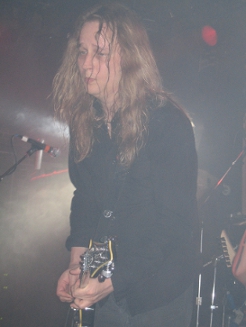 6. Impossible Brutality (Enemy of God, 2005). During the first verse, MP spouted, “All I see is terror. All I see is pain. All I see is mothers dragging children to their graves.” At approximately the 1:50 mark CG’s bass lines came to the forefront driving the song to, where else, the grave.
6. Impossible Brutality (Enemy of God, 2005). During the first verse, MP spouted, “All I see is terror. All I see is pain. All I see is mothers dragging children to their graves.” At approximately the 1:50 mark CG’s bass lines came to the forefront driving the song to, where else, the grave.
